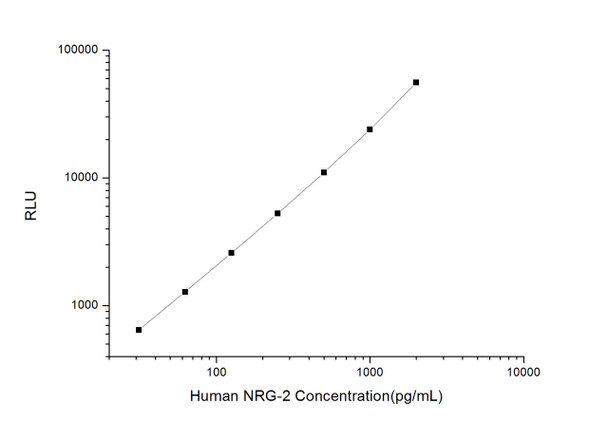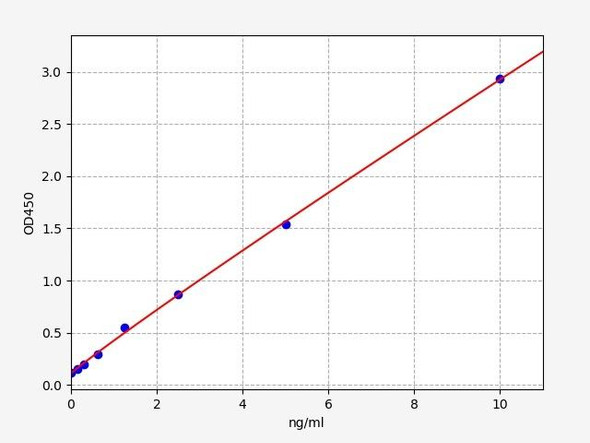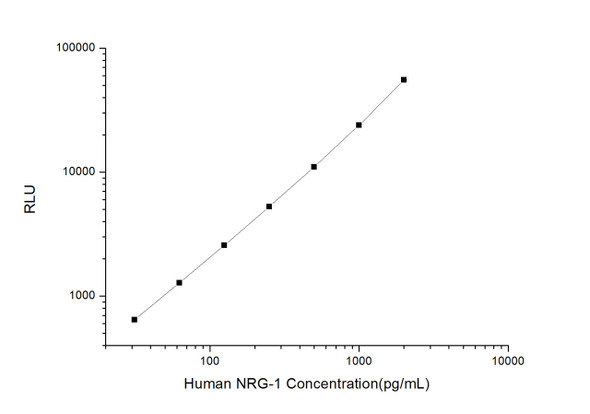Human Immunology ELISA Kits 11
Human NRG-2 (Neuregulin 2) CLIA Kit (HUES00539)
- SKU:
- HUES00539
- Product Type:
- ELISA Kit
- ELISA Type:
- CLIA Kit
- Size:
- 96 Assays
- Sensitivity:
- 18.75pg/mL
- Range:
- 31.25-2000pg/mL
- ELISA Type:
- Sandwich
- Synonyms:
- NRG2, DON1, HRG2, NTAK
- Reactivity:
- Human
- Sample Type:
- Serum, plasma and other biological fluids
Description
| Assay type: | Sandwich |
| Format: | 96T |
| Assay time: | 4.5h |
| Reactivity: | Human |
| Detection method: | Chemiluminescence |
| Detection range: | 31.25-2000 pg/mL |
| Sensitivity: | 18.75 pg/mL |
| Sample volume: | 100µL |
| Sample type: | Serum, plasma and other biological fluids |
| Repeatability: | CV < 15% |
| Specificity: | This kit recognizes Human NRG-2 in samples. No significant cross-reactivity or interference between Human NRG-2 and analogues was observed. |
This kit uses Sandwich-CLIA as the method. The micro CLIA plate provided in this kit has been pre-coated with an antibody specific to Human NRG-2. Standards or samples are added to the appropriate micro CLIA plate wells and combined with the specific antibody. Then a biotinylated detection antibody specific for Human NRG-2 and Avidin-Horseradish Peroxidase (HRP) conjugate are added to each micro plate well successively and incubated. Free components are washed away. The substrate solution is added to each well. Only those wells that contain Human NRG-2, biotinylated detection antibody and Avidin-HRP conjugate will appear fluorescence. The Relative light unit (RLU) value is measured spectrophotometrically by the Chemiluminescence immunoassay analyzer. The RLU value is positively associated with the concentration of Human NRG-2. The concentration of Human NRG-2 in the samples can be calculated by comparing the RLU of the samples to the standard curve.
| UniProt Protein Function: | NRG2: Direct ligand for ERBB3 and ERBB4 tyrosine kinase receptors. Concomitantly recruits ERBB1 and ERBB2 coreceptors, resulting in ligand-stimulated tyrosine phosphorylation and activation of the ERBB receptors. May also promote the heterodimerization with the EGF receptor. Belongs to the neuregulin family. 8 isoforms of the human protein are produced by alternative splicing. |
| UniProt Protein Details: | Protein type:Ligand, receptor tyrosine kinase; Membrane protein, integral Chromosomal Location of Human Ortholog: 5q31. 2 Cellular Component: extracellular space; extracellular region; plasma membrane; integral to membrane Molecular Function:growth factor activity; receptor binding Biological Process: epidermal growth factor receptor signaling pathway; embryonic development; phosphoinositide-mediated signaling; fibroblast growth factor receptor signaling pathway; nerve growth factor receptor signaling pathway; organ development; innate immune response; signal transduction |
| NCBI Summary: | This gene encodes a novel member of the neuregulin family of growth and differentiation factors. Through interaction with the ERBB family of receptors, this protein induces the growth and differentiation of epithelial, neuronal, glial, and other types of cells. The gene consists of 12 exons and the genomic structure is similar to that of neuregulin 1, another member of the neuregulin family of ligands. The products of these genes mediate distinct biological processes by acting at different sites in tissues and eliciting different biological responses in cells. This gene is located close to the region for demyelinating Charcot-Marie-Tooth disease locus, but is not responsible for this disease. Alternative transcript variants encoding distinct isoforms have been described. [provided by RefSeq, May 2010] |
| UniProt Code: | O14511 |
| NCBI GenInfo Identifier: | 3914154 |
| NCBI Gene ID: | 9542 |
| NCBI Accession: | O14511. 1 |
| UniProt Related Accession: | O14511 |
| Molecular Weight: | 70,637 Da |
| NCBI Full Name: | Pro-neuregulin-2, membrane-bound isoform |
| NCBI Synonym Full Names: | neuregulin 2 |
| NCBI Official Symbol: | NRG2 |
| NCBI Official Synonym Symbols: | DON1; HRG2; NTAK |
| NCBI Protein Information: | pro-neuregulin-2, membrane-bound isoform; pro-NRG2; divergent of neuregulin-1; neural- and thymus-derived activator for ErbB kinases |
| UniProt Protein Name: | Pro-neuregulin-2, membrane-bound isoform |
| UniProt Synonym Protein Names: | Divergent of neuregulin-1; DON-1; Neural- and thymus-derived activator for ERBB kinases; NTAK |
| Protein Family: | Pro-neuregulin |
| UniProt Gene Name: | NRG2 |
| UniProt Entry Name: | NRG2_HUMAN |
As the RLU values of the standard curve may vary according to the conditions of the actual assay performance (e. g. operator, pipetting technique, washing technique or temperature effects), the operator should establish a standard curve for each test. Typical standard curve and data is provided below for reference only.
| Concentration (pg/mL) | RLU | Average | Corrected |
| 2000 | 53154 58288 | 55721 | 55693 |
| 1000 | 22432 25516 | 23974 | 23946 |
| 500 | 11797 10267 | 11032 | 11004 |
| 250 | 5097 5491 | 5294 | 5266 |
| 125 | 2732 2484 | 2608 | 2580 |
| 62.5 | 1385 1237 | 1311 | 1283 |
| 31.25 | 664 684 | 674 | 646 |
| 0 | 27 29 | 28 | -- |
Precision
Intra-assay Precision (Precision within an assay): 3 samples with low, mid range and high level Human NRG-2 were tested 20 times on one plate, respectively.
Inter-assay Precision (Precision between assays): 3 samples with low, mid range and high level Human NRG-2 were tested on 3 different plates, 20 replicates in each plate.
| Intra-assay Precision | Inter-assay Precision | |||||
| Sample | 1 | 2 | 3 | 1 | 2 | 3 |
| n | 20 | 20 | 20 | 20 | 20 | 20 |
| Mean (pg/mL) | 105.32 | 176.07 | 901.79 | 107.59 | 174.50 | 914.38 |
| Standard deviation | 11.32 | 19.37 | 82.24 | 9.63 | 12.79 | 69.22 |
| C V (%) | 10.75 | 11.00 | 9.12 | 8.95 | 7.33 | 7.57 |
Recovery
The recovery of Human NRG-2 spiked at three different levels in samples throughout the range of the assay was evaluated in various matrices.
| Sample Type | Range (%) | Average Recovery (%) |
| Serum (n=5) | 85-97 | 91 |
| EDTA plasma (n=5) | 97-110 | 104 |
| Cell culture media (n=5) | 91-104 | 99 |
Linearity
Samples were spiked with high concentrations of Human NRG-2 and diluted with Reference Standard & Sample Diluent to produce samples with values within the range of the assay.
| Serum (n=5) | EDTA plasma (n=5) | Cell culture media (n=5) | ||
| 1:2 | Range (%) | 92-110 | 101-116 | 95-108 |
| Average (%) | 100 | 107 | 100 | |
| 1:4 | Range (%) | 98-117 | 87-100 | 94-108 |
| Average (%) | 107 | 93 | 99 | |
| 1:8 | Range (%) | 100-118 | 99-114 | 94-108 |
| Average (%) | 108 | 105 | 99 | |
| 1:16 | Range (%) | 96-109 | 87-102 | 101-116 |
| Average (%) | 102 | 93 | 108 |
An unopened kit can be stored at 4°C for 1 month. If the kit is not used within 1 month, store the items separately according to the following conditions once the kit is received.
| Item | Specifications | Storage |
| Micro CLIA Plate(Dismountable) | 8 wells ×12 strips | -20°C, 6 months |
| Reference Standard | 2 vials | |
| Concentrated Biotinylated Detection Ab (100×) | 1 vial, 120 µL | |
| Concentrated HRP Conjugate (100×) | 1 vial, 120 µL | -20°C(shading light), 6 months |
| Reference Standard & Sample Diluent | 1 vial, 20 mL | 4°C, 6 months |
| Biotinylated Detection Ab Diluent | 1 vial, 14 mL | |
| HRP Conjugate Diluent | 1 vial, 14 mL | |
| Concentrated Wash Buffer (25×) | 1 vial, 30 mL | |
| Substrate Reagent A | 1 vial, 5 mL | 4°C (shading light) |
| Substrate Reagent B | 1 vial, 5 mL | 4°C (shading light) |
| Plate Sealer | 5 pieces | |
| Product Description | 1 copy | |
| Certificate of Analysis | 1 copy |
- Set standard, test sample and control (zero) wells on the pre-coated plate and record theirpositions. It is recommended to measure each standard and sample in duplicate. Note: addall solutions to the bottom of the plate wells while avoiding contact with the well walls. Ensuresolutions do not foam when adding to the wells.
- Aliquot 100µl of standard solutions into the standard wells.
- Add 100µl of Sample / Standard dilution buffer into the control (zero) well.
- Add 100µl of properly diluted sample (serum, plasma, tissue homogenates and otherbiological fluids. ) into test sample wells.
- Cover the plate with the sealer provided in the kit and incubate for 90 min at 37°C.
- Aspirate the liquid from each well, do not wash. Immediately add 100µL of BiotinylatedDetection Ab working solution to each well. Cover the plate with a plate seal and gently mix. Incubate for 1 hour at 37°C.
- Aspirate or decant the solution from the plate and add 350µL of wash buffer to each welland incubate for 1-2 minutes at room temperature. Aspirate the solution from each well andclap the plate on absorbent filter paper to dry. Repeat this process 3 times. Note: a microplatewasher can be used in this step and other wash steps.
- Add 100µL of HRP Conjugate working solution to each well. Cover with a plate seal andincubate for 30 min at 37°C.
- Aspirate or decant the solution from each well. Repeat the wash process for five times asconducted in step 7.
- Add 100µL of Substrate mixture solution to each well. Cover with a new plate seal andincubate for no more than 5 min at 37°C. Protect the plate from light.
- Determine the RLU value of each well immediately.






